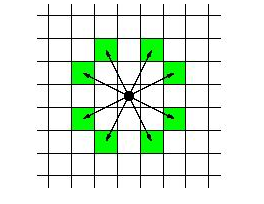Description
Your task is to write a program to calculate the minimum number of moves needed for a knight to reach one point from another. The possible knight moves are shown in Figure 1.

Figure 1 Possible knight moves on the board
Input
The first line contains an integer T (≤10), indicating the number of test cases.
In every case, the first line contains an integer N (≤500), indicating the size of the chess board (the entire board has size N × N). The second and third line contain pair of integers (srcR, srcC), and (dstR, dstC), specifying the starting and ending position of the knight on the board (0 ≤ srcR, srcC, dstR, dstC ≤ N – 1).
Output
For every case, output the minimum distance on a single line. If starting point and ending point are equal, distance is 0. If the knight can’t reach the ending point, distance is -1.
Sample Input
2 1 0 0 0 0 10 0 1 8 9
Sample Output
0 6
分析:
简单的BFS查找,注意判断状态是否合法即可。
代码:
1 // Problem#: 1781 2 // Submission#: 1896080 3 // The source code is licensed under Creative Commons Attribution-NonCommercial-ShareAlike 3.0 Unported License 4 // URI: http://creativecommons.org/licenses/by-nc-sa/3.0/ 5 // All Copyright reserved by Informatic Lab of Sun Yat-sen University 6 #include <iostream> 7 #include <queue> 8 #include <cstring> 9 using namespace std; 10 11 #define MAX 500 12 13 struct node{ 14 int x, y, z; 15 node(int r, int s, int t){ 16 x = r; 17 y = s; 18 z = t; 19 } 20 }; 21 22 int n, a, b, c, d; 23 bool visit[MAX][MAX]; 24 int move[8][2] = {{-2, -1}, {-1, -2}, {-2, 1}, {-1, 2}, {1, 2}, {2, 1}, {1, -2}, {2, -1}}; 25 26 inline bool judge(int x, int y){ 27 return x >= 0 && x < n && y >= 0 && y < n; 28 } 29 30 int bfs(){ 31 queue<node> buffer; 32 memset(visit, false, sizeof(visit)); 33 buffer.push(node(a, b, 0)); 34 visit[a][b] = true; 35 while (!buffer.empty()) { 36 node tmp = buffer.front(); 37 if (tmp.x == c && tmp.y == d) 38 return tmp.z; 39 buffer.pop(); 40 for (int i = 0 ; i < 8 ; ++i) { 41 int tx = tmp.x + move[i][0]; 42 int ty = tmp.y + move[i][1]; 43 int tz = tmp.z + 1; 44 if (judge(tx, ty) && !visit[tx][ty]){ 45 buffer.push(node(tx, ty, tz)); 46 visit[tx][ty] = true; 47 } 48 } 49 } 50 return -1; 51 } 52 53 int main() { 54 int t; 55 cin >> t; 56 while (t--) { 57 cin >> n; 58 cin >> a >> b >> c >> d; 59 cout << bfs() << endl; 60 } 61 return 0; 62 }





















 609
609

 被折叠的 条评论
为什么被折叠?
被折叠的 条评论
为什么被折叠?








